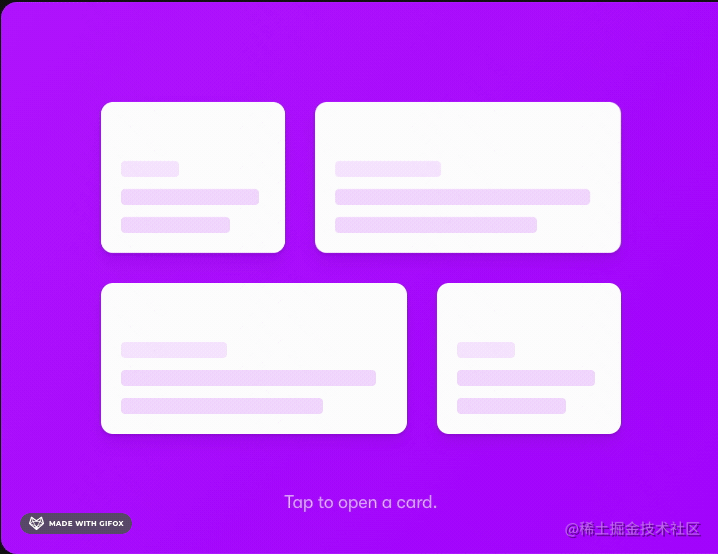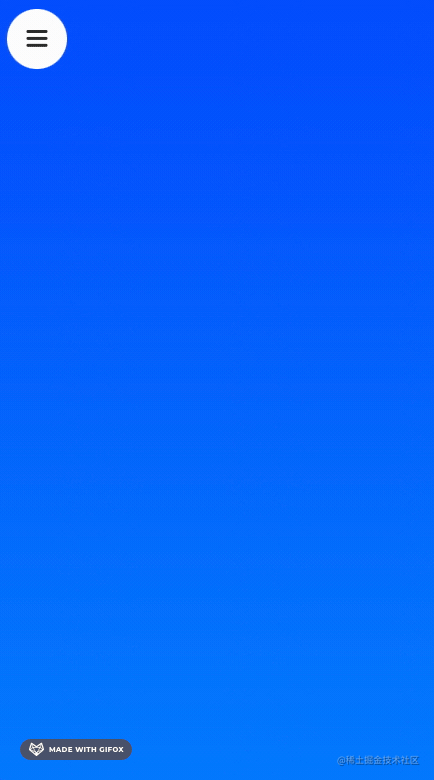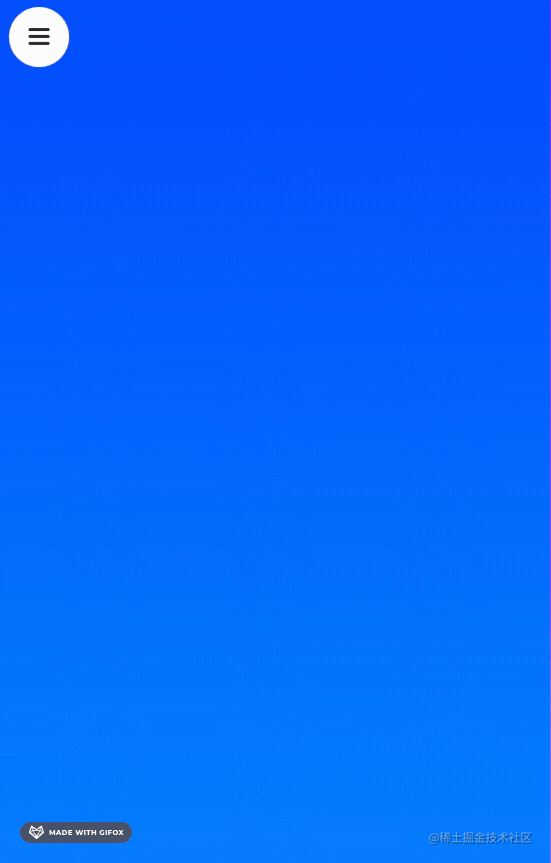React動畫實現方案之 Framer Motion,讓你的頁面「自己」動起來
前言
相信很多前端同學都或多或少和動畫打過交道。有的時候是產品想要的過度效果;有的時候是UI想要的酷炫動畫。但是有沒有人考慮過,是不是我們的頁面上面的每一次變化,都可以像是自然而然的變化;是不是每一次使用者點選所產生的互動,都可以在頁面上活過來呢?
歡迎你開啟了新的前端動畫世界——《Framer Motion》
效果體驗
這裡,我在framer官網上面給大家錄製了一下大概的使用效果。

在我們的常規認知中,實現這樣的效果其實需要很多的css來實現,或者說需要我們進行大量的客製化化邏輯編寫。但是如果我們使用framer motion的話,只需要如下程式碼:
import { AnimatePresence, motion } from 'framer-motion';
const [selectedId, setSelectedId] = useState(null);
{items.map(item => (
<motion.div layoutId={item.id} onClick={() => setSelectedId(item.id)}>
<motion.h5>{item.subtitle}</motion.h5>
<motion.h2>{item.title}</motion.h2>
</motion.div>
))}
<AnimatePresence>
{selectedId && (
<motion.div layoutId={selectedId}>
<motion.h5>{item.subtitle}</motion.h5>
<motion.h2>{item.title}</motion.h2>
<motion.button onClick={() => setSelectedId(null)} />
</motion.div>
)}
</AnimatePresence>
從上面的實現我們可以看出,framer-motion可以說是我們在用react動效開發過程中的必備利器。那麼接下來,我給大家簡單介紹一些framer motion的基礎用法。
快速開始
Framer Motion 需要 React 18 或更高版本。
安裝
從npm安裝framer-motion
npm install framer-motion
輸入
安裝後,您可以通過framer-motion引入Framer Motion
import { motion } from "framer-motion"
export const MyComponent = ({ isVisible }) => (
<motion.div animate={{ opacity: isVisible ? 1 : 0 }} />
)
使用方式
Framer motion的核心API是motion的元件。每個HTML和SVG標籤都有對應的motion元件。
他們渲染的結果與對應的原生元件完全一致,並在其之上增加了一些動畫和手勢相關的props。
比如:
<motion.div />
<motion.span />
<motion.h1 />
<motion.svg />
...
範例
比如我們現在想要實現一個側邊欄效果。
節點的掛載與解除安裝(mount、unmount)

如果我們自己來實現的話,可能要考慮它的keyframe,它的初始狀態與最終的css樣式。那麼如果用framer-motion來如何實現呢?
首先我們來設計一個會動的按鈕Icon:
import * as React from "react";
import { motion } from "framer-motion";
const Path = props => (
<motion.path
fill="transparent"
strokeWidth="3"
stroke="hsl(0, 0%, 18%)"
strokeLinecap="round"
{...props}
/>
);
const MenuToggle = ({ toggle }) => (
<button onClick={toggle}>
<svg width="23" height="23" viewBox="0 0 23 23">
<Path
variants={{
closed: { d: "M 2 2.5 L 20 2.5" },
open: { d: "M 3 16.5 L 17 2.5" }
}}
/>
<Path
d="M 2 9.423 L 20 9.423"
variants={{
closed: { opacity: 1 },
open: { opacity: 0 }
}}
transition={{ duration: 0.1 }}
/>
<Path
variants={{
closed: { d: "M 2 16.346 L 20 16.346" },
open: { d: "M 3 2.5 L 17 16.346" }
}}
/>
</svg>
</button>
);
接下來,就由這個按鈕來控制側邊欄的展示(mount)與隱藏(unmount):
import * as React from "react";
import { useRef } from "react";
import { motion, useCycle } from "framer-motion";
import { useDimensions } from "./use-dimensions";
const sidebar = {
open: (height = 1000) => ({
clipPath: `circle(${height * 2 + 200}px at 40px 40px)`,
transition: {
type: "spring",
stiffness: 20,
restDelta: 2
}
}),
closed: {
clipPath: "circle(30px at 40px 40px)",
transition: {
delay: 0.5,
type: "spring",
stiffness: 400,
damping: 40
}
}
};
export const Example = () => {
const [isOpen, toggleOpen] = useCycle(false, true);
const containerRef = useRef(null);
const { height } = useDimensions(containerRef);
return (
<motion.nav
initial={false}
animate={isOpen ? "open" : "closed"}
custom={height}
ref={containerRef}
>
<motion.div className="background" variants={sidebar} />
<MenuToggle toggle={() => toggleOpen()} />
</motion.nav>
);
};
也就是說,其實我們更多需要做的事情,從思考如何設計各元素之間的css聯動與keyframe書寫變成了如何按照檔案寫好framer-motion的設定。哪個更輕鬆相信大家一目瞭然。
列表
側邊欄一般都是帶有選單的,那麼我們是不是可以讓這個側邊欄也有一個逐次出現的效果呢?就像這樣:

這裡我們是不是已經開始肌肉記憶般的計算延遲時間,思考如何進行整體效果的分配。那麼如果這裡我們使用frame motion,它的實現方式應該是怎麼樣的呢?
首先我們先來進行單個Item的封裝:
import * as React from "react";
import { motion } from "framer-motion";
const variants = {
open: {
y: 0,
opacity: 1,
transition: {
y: { stiffness: 1000, velocity: -100 }
}
},
closed: {
y: 50,
opacity: 0,
transition: {
y: { stiffness: 1000 }
}
}
};
const colors = ["#FF008C", "#D309E1", "#9C1AFF", "#7700FF", "#4400FF"];
export const MenuItem = ({ i }) => {
const style = { border: `2px solid ${colors[i]}` };
return (
<motion.li
variants={variants}
whileHover={{ scale: 1.1 }}
whileTap={{ scale: 0.95 }}
>
<div className="icon-placeholder" style={style} />
<div className="text-placeholder" style={style} />
</motion.li>
);
};
然後我們在已封裝Item的基礎上,再進行整個選單的封裝:
import * as React from "react";
import { motion } from "framer-motion";
const itemIds = [0, 1, 2, 3, 4];
const variants = {
open: {
transition: { staggerChildren: 0.07, delayChildren: 0.2 }
},
closed: {
transition: { staggerChildren: 0.05, staggerDirection: -1 }
}
};
export const Navigation = () => (
<motion.ul variants={variants}>
{itemIds.map(i => (
<MenuItem i={i} key={i} />
))}
</motion.ul>
);
沒錯,動畫!就是這麼簡單!
更多API
更詳細、更具體的功能大家可以參考下官方的使用檔案,我就不在這裡一一列舉了。
美中不足
其實不難看出,不論是實現的效果,還是使用方式,對於前端的同學來說framer-motion都是非常友好的工具。這一點從npm的Weekly Downloads以及github的star上面都不難看出。


但是目前也有一個問題,那就是包的體積問題。

這個包的大小對於部分的系統來說,還是不夠友好。這也是很多人不選擇使用它的原因。